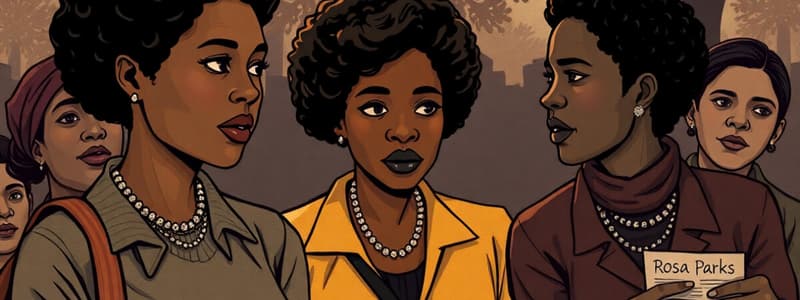Podcast
Questions and Answers
What type of correspondence does the General Correspondence series include?
What type of correspondence does the General Correspondence series include?
- All letters received from prominent individuals and the general public. (correct)
- Only greeting cards and children's drawings.
- Only letters from Rosa Parks's family members.
- Only letters from organizations and event planners.
What materials are documented in the Miscellany series?
What materials are documented in the Miscellany series?
- Insurance, employment records, and medical records among other documents. (correct)
- Only appointment calendars and address books.
- Only financial records and biographical material.
- Primarily printed materials related to civil rights events.
What is the primary arrangement method used for the Writings, Notes, and Statements series?
What is the primary arrangement method used for the Writings, Notes, and Statements series?
- Chronologically by date of writing.
- Alphabetically by type of material. (correct)
- By topic and type of material.
- By the name of the person addressed.
Which series includes materials pertaining to Rosa Parks's speaking engagements?
Which series includes materials pertaining to Rosa Parks's speaking engagements?
How are the books owned by Rosa Parks organized within their collection?
How are the books owned by Rosa Parks organized within their collection?
What event marked Rosa Parks's arrest in 1955?
What event marked Rosa Parks's arrest in 1955?
Which organization did Rosa Parks found to promote youth development?
Which organization did Rosa Parks found to promote youth development?
What year did the Library formally open Parks's collection to researchers?
What year did the Library formally open Parks's collection to researchers?
What is the majority of the material in Rosa Parks's collection documented from?
What is the majority of the material in Rosa Parks's collection documented from?
Which major civil rights event did Rosa Parks participate in during 1964?
Which major civil rights event did Rosa Parks participate in during 1964?
What was the primary goal of the Civil Rights Act of 1964?
What was the primary goal of the Civil Rights Act of 1964?
During which time frame was the exhibition commemorating the Civil Rights Act of 1964 held?
During which time frame was the exhibition commemorating the Civil Rights Act of 1964 held?
What type of content was featured in the audiovisual stations throughout the exhibition?
What type of content was featured in the audiovisual stations throughout the exhibition?
Which foundation provided a generous grant for the Civil Rights Act of 1964 exhibition?
Which foundation provided a generous grant for the Civil Rights Act of 1964 exhibition?
What aspect of society did the Civil Rights Act of 1964 significantly impact?
What aspect of society did the Civil Rights Act of 1964 significantly impact?
What was the outcome of the Brown v. Board of Education decision?
What was the outcome of the Brown v. Board of Education decision?
What action did Rosa Parks take that ignited the Montgomery Bus Boycott?
What action did Rosa Parks take that ignited the Montgomery Bus Boycott?
What strategy did Southern states employ after the Brown decision?
What strategy did Southern states employ after the Brown decision?
What was the focus of the Mississippi Freedom Summer organized by the NAACP?
What was the focus of the Mississippi Freedom Summer organized by the NAACP?
What role did Herbert Hill hold within the NAACP?
What role did Herbert Hill hold within the NAACP?
What significant action did Harry T. Moore undertake in 1937 with NAACP support?
What significant action did Harry T. Moore undertake in 1937 with NAACP support?
Which strategy did Robert L. Carter recommend for the Brown v. Board of Education case?
Which strategy did Robert L. Carter recommend for the Brown v. Board of Education case?
What tragic event occurred on Christmas night in 1951 involving Harry T. Moore?
What tragic event occurred on Christmas night in 1951 involving Harry T. Moore?
What was the primary goal of the NAACP's 'Fight for Freedom' campaign initiated in 1953?
What was the primary goal of the NAACP's 'Fight for Freedom' campaign initiated in 1953?
Who succeeded Walter White as the NAACP executive secretary in 1955?
Who succeeded Walter White as the NAACP executive secretary in 1955?
Flashcards
Rosa Parks Papers Manuscript Collection
Rosa Parks Papers Manuscript Collection
The collection of materials pertaining to the life of Rosa Parks, including correspondence, writings, and photographs, classified into different series.
Family Papers
Family Papers
This series contains personal letters, notes, financial records, and other items related to Rosa Parks's family members.
General Correspondence
General Correspondence
This series includes letters from famous people, general correspondence, and greetings.
Subject File
Subject File
Signup and view all the flashcards
Writings, Notes, and Statements
Writings, Notes, and Statements
Signup and view all the flashcards
What is the scope of the Rosa Parks Collection?
What is the scope of the Rosa Parks Collection?
Signup and view all the flashcards
What types of materials are included in the Rosa Parks Collection?
What types of materials are included in the Rosa Parks Collection?
Signup and view all the flashcards
What was the significance of Rosa Parks's arrest in 1955?
What was the significance of Rosa Parks's arrest in 1955?
Signup and view all the flashcards
How does the Rosa Parks Collection document her involvement in Civil Rights activities?
How does the Rosa Parks Collection document her involvement in Civil Rights activities?
Signup and view all the flashcards
What organizations was Rosa Parks involved with?
What organizations was Rosa Parks involved with?
Signup and view all the flashcards
What is the significance of the Civil Rights Act of 1964?
What is the significance of the Civil Rights Act of 1964?
Signup and view all the flashcards
What areas of life did the Civil Rights Act of 1964 affect?
What areas of life did the Civil Rights Act of 1964 affect?
Signup and view all the flashcards
What was the purpose of the exhibition "The Civil Rights Act of 1964: A Long Struggle for Freedom"?
What was the purpose of the exhibition "The Civil Rights Act of 1964: A Long Struggle for Freedom"?
Signup and view all the flashcards
How did the "The Civil Rights Act of 1964: A Long Struggle for Freedom" exhibition engage with the civil rights movement?
How did the "The Civil Rights Act of 1964: A Long Struggle for Freedom" exhibition engage with the civil rights movement?
Signup and view all the flashcards
Who supported the "The Civil Rights Act of 1964: A Long Struggle for Freedom" exhibition?
Who supported the "The Civil Rights Act of 1964: A Long Struggle for Freedom" exhibition?
Signup and view all the flashcards
Separate but equal
Separate but equal
Signup and view all the flashcards
Brown v. Board of Education
Brown v. Board of Education
Signup and view all the flashcards
Montgomery Bus Boycott
Montgomery Bus Boycott
Signup and view all the flashcards
NAACP's role in desegregation
NAACP's role in desegregation
Signup and view all the flashcards
Herbert Hill's Work for Civil Rights
Herbert Hill's Work for Civil Rights
Signup and view all the flashcards
The March on Washington
The March on Washington
Signup and view all the flashcards
Mississippi Freedom Summer
Mississippi Freedom Summer
Signup and view all the flashcards
Harry T. Moore's fight for pay equity
Harry T. Moore's fight for pay equity
Signup and view all the flashcards
NAACP's "Fight for Freedom" campaign
NAACP's "Fight for Freedom" campaign
Signup and view all the flashcards
Marguerite Belafonte's role in the "Fight for Freedom" campaign
Marguerite Belafonte's role in the "Fight for Freedom" campaign
Signup and view all the flashcards
Robert L. Carter's contribution to Brown v. Board
Robert L. Carter's contribution to Brown v. Board
Signup and view all the flashcards
Unanimous decision in Brown v. Board
Unanimous decision in Brown v. Board
Signup and view all the flashcards
Study Notes
Rosa Parks Papers Collection
- The Rosa Parks papers span 1866-2006, with most material from 1955-2000.
- The collection consists of approximately 7,500 items in the Manuscript Division and 2,500 photographs.
- The collection documents Parks's private life and civil rights activism.
- The collection was a gift from the Howard G. Buffett Foundation in 2016.
- The Library received the materials in late 2014, opened them to researchers in 2015, and digitized them.
Family Papers
- Include correspondence with husband, mother, and brother.
- The largest number of letters in the collection are from Parks to her husband and mother.
- Letters from her brother, Sylvester McCauley, primarily concerned moving to Detroit.
Key Events Documented
- Papers detail events surrounding Parks's 1955 arrest and the Montgomery Bus Boycott.
- Descriptions of her work for Congressman John Conyers.
- Records of major civil rights events like the Prayer Pilgrimage for Freedom (1957), March on Washington (1963), Mississippi Freedom Project (1964), and the Poor People's Campaign (1968).
- Materials related to Parks's Presidential Medal of Freedom and Congressional Gold Medal.
- The collection documents the Brown v. Board of Education decision, the Montgomery Bus Boycott, and the Civil Rights Movement.
Affiliations Documents
- The collection details Parks's connection with the Rosa and Raymond Parks Institute for Self Development (founded by Parks and Elaine Eason Steele), Hampton Institute, Highlander Folk School, Martin Luther King, Jr. Center, NAACP, SCLC, and Saint Matthew AME Church.
Digitization and Access
- The vast majority of the collection is digitized.
- Researchers can access materials in the Manuscript and Prints and Photographs reading rooms.
- Approximately 6% of the manuscript items are not yet digitized due to copyright or rights clearance issues.
- Children's greeting cards have a representative sample.
Organization of the Collection
- The collection is divided into eleven series.
- Several series focus on specific types of materials (e.g., Family Papers, General Correspondence, Subject File, Writings, Notes, Statements).
- Other series chronicle events, resolutions/honors, and various aspects of Parks's life (e.g., printed matter, books she owned, or medals she received).
- One series focuses on oversize material (larger items).
Transcription and Crowdsourcing
-
Some items were transcribed by volunteers from the By the People crowdsourcing project.
-
Transcriptions can be accessed through the "Image w/Text" or "Text" options.
-
A full transcript for all images in a given object record can be seen by choosing "Text (all pages)."
-
Transcription datasets are available online.
Extra Information
- A 2014-2016 exhibition commemorated the 50th anniversary of the 1964 Civil Rights Act.
- This act prohibited discrimination based on race, color, religion, sex, or national origin in various areas (voting, public accommodations, facilities, education, federally funded programs, employment).
- The exhibition illustrated this period using archival footage and contemporary interviews.
- The exhibition was supported by the Newman's Own Foundation and HISTORY®.
- NAACP played a crucial role in the Civil Rights Movement, with key figures like Thurgood Marshall, Roy Wilkins, and Medgar Evers.
- Organizations like the NAACP Youth Council and the NAACP Legal Defense Fund were involved and highly active in the struggle.
- Key events and legislation include the Brown v. Board of Education ruling, the Montgomery Bus Boycott, the March on Washington, Mississippi Freedom Summer, and major civil rights legislation like the Civil Rights Act of 1957, 1964, the Voting Rights Act of 1965, and the Fair Housing Act of 1968.
- The NAACP faced resistance, including attempts to ban the organization and threats against its members by white supremacist groups such as the Ku Klux Klan.
- Key NAACP members fought for school desegregation, voter registration, and the end of segregation and discrimination.
- The NAACP had a significant fundraising campaign called "Fight for Freedom" in the 1950s.
- The Brown v. Board of Education decision was unanimous and overturned the "separate but equal" doctrine.
- Brown v. Board of Education involved several cases, hearings, and a rehearing.
Studying That Suits You
Use AI to generate personalized quizzes and flashcards to suit your learning preferences.





